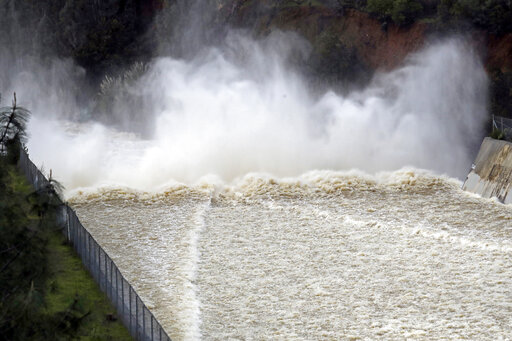SAN JOSE, Calif. — Worried that an earthquake could collapse a big dam south of San Francisco, officials have ordered its reservoir to be completely drained by October to reduce the risk of floodwaters spilling into Silicon Valley.
The 240-foot (73-meter) high earthen Anderson Dam, built in 1950 between San Jose and the community of Morgan Hill, poses too great a risk of collapse and must be fully drained by Oct. 1, according to the Federal Energy Regulatory Commission, which regulates dams, the Mercury News reported.
“It is unacceptable to maintain the reservoir at an elevation higher than necessary when it can be reduced, thereby decreasing the risk to public safety and the large population downstream,” David Capka, director of the commission’s Division of Dam Safety and Inspections, wrote last week in a letter to the Santa Clara Valley Water District.
Since 2009, the dam’s water level has been kept at a maximum of 74 percent of capacity because of an assessment that it could fail in a 7.2 quake. The reservoir is built along the Calaveras Fault. On Monday, amid the threat of another drought in California, Anderson Reservoir was just 29% full.
A seismic retrofit project has been underway because of its state classification in 2017 as being an “extremely high” downstream hazard.
The Santa Clara Valley Water District said in a statement Monday that officials agree with the commission’s assessment that the reservoir should be drained ahead of the retrofit project, which is “complicated and time consuming.”
“Valley Water has been working with several state and federal agencies through the years to secure the proper permits as the scope of the project has increased due to additional safety and design requirements,” Valley Water CEO Norma Camacho said.
“A priority will be to design and build a large outlet pipe, which will provide greater control over the water levels and increase public safety,” she added in the statement.
Camacho said draining the largest reservoir in the district will likely kill wildlife downstream in Coyote Creek, including endangered steelhead trout, amphibians and reptiles. Coyote Creek flows from the dam through downtown San Jose to San Francisco Bay.
If the dam collapsed, runoff could damage cities and rural areas from the San Francisco Bay through Monterey Bay to the south, including much of Silicon Valley, the water district said in a statement.
More than 14,000 residents had to be evacuated in 2017 as water from swollen Coyote Creek, downstream of the Anderson Reservoir, flooded homes and temporarily shut down a portion of a freeway.
It came the same month as a spillway failed at the nation’s tallest dam, in Oroville in Northern California, leading officials to order the evacuation of nearly 200,000 people. The dam ultimately held, but an independent investigation cited ”a long-term systemic failure ” by regulators and the dam industry to recognize and address warning signs.
California spent $1.1 billion repairing the Lake Oroville spillway, enacted new emergency plan requirements and launched a review of 93 other dams with similar spillways.
An AP investigation last year identified at least 1,688 high-hazard dams rated in poor or unsatisfactory condition in 44 states and Puerto Rico.
Complicating the issue this year, California may be heading into a new drought.
Stored water is an important part of the south San Francisco Bay Area’s supply — with enough water for the annual needs of at least 130,000 people as well as what the district considers an emergency supply.
“While residents have done an excellent job of conserving water since 2013, another drought during this time frame could require everyone to significantly decrease their water use,” Camacho said.
The agency is exploring other sources of water from outside Santa Clara County, she said.
About the photo: In this Feb. 21, 2017 file photo, water from the Lake Anderson Reservoir gushes down a spillway in Morgan Hill, Calif. U.S. officials are worried that an earthquake could collapse a big dam near Silicon Valley. They ordered its reservoir to be completely drained by October 2020, due to concerns that the dam could send floodwaters into communities. Retrofit plans have been in the works for years and the dam’s water level has been kept at a maximum of 74% since 2009. As of Monday, Feb. 24, 2020, the reservoir was just 29% full. (AP Photo/Marcio Jose Sanchez, File)
Was this article valuable?
Here are more articles you may enjoy.


 J&J Talc Jury Awards $1.56 Billion to Asbestos Cancer Victim
J&J Talc Jury Awards $1.56 Billion to Asbestos Cancer Victim  Tesla Drivers Are Buying Escape Tools and Cars to Avoid Getting Trapped Inside
Tesla Drivers Are Buying Escape Tools and Cars to Avoid Getting Trapped Inside  Cat Bonds Linked to Wildfires Lose ‘Once Untouchable’ Status
Cat Bonds Linked to Wildfires Lose ‘Once Untouchable’ Status  NYT Asks Judge to Dismiss Trump’s ‘Implausible’ Defamation Suit
NYT Asks Judge to Dismiss Trump’s ‘Implausible’ Defamation Suit 